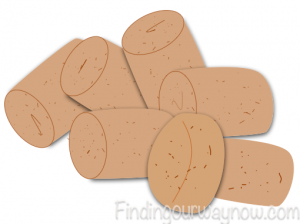Have ever thought about wine corks? One of the most common questions I got at the wineries I worked had very little to do with the wine. It was this:
Which are better… natural wine corks or synthetic wine corks?
This is quite the tricky question, and I’d usually have to dance around the answer, as wineries would often use some of both, and the last thing I wanted to do was tell someone “this is bad for the wine, and yet we’re selling it to you.”
Let me be clear here before I start. Both sides have some great pros and some bad cons. Let’s take a look at the differences and then you can decide.
Wine Corks
First, let’s take a look synthetic/plastic wine corks.
Plastic wine corks prevent cork taint. Plastic wine corks don’t contain TCA, and they can be sterilized for use in your bottle. Bottles with natural corks need to be stored on their side or upside down so the cork stays moist. If it dries out, it can rot, which is no fun. With plastic wine corks, you don’t have to worry about that.
Natural wine cork harvesting is destroying our planet. This is quite a common cry from those who only use synthetic wine corks. However, it’s mostly false. Cork is a renewable resource. They harvest the bark of the trees, and then it grows back. These trees aren’t cut down. It still looks pretty bad though.

Plastic wine corks are cheaper. This is good for the winemakers, and possibly good for us. If they’re spending less money on corks, they may not have to charge as much for the wine. That doesn’t mean they will though. Switching to synthetic wine corks and leaving the price the same is a great way for a winery to make some extra dough.
Now, how about the arguments for the use of natural wine corks?
Tradition. This is also a tough one to argue. On one hand, doing something because you’ve always done it is a bad reason for doing it. On the other hand, we have been bottling wine for centuries now, and there’s a certain romance to it. My wife and I were dining at Raspberries in Harrisburg last week and when the waiter brought the wine I immediately glanced to see if it was a real cork. It was, and I instantly felt like it would be a better wine. The same way a label can change the taste of the wine, just seeing a natural cork can make a positive impression too.
Aeration. Wine requires a little oxygen to age. Too much is a bad thing, though. Natural wine cork has shown a pretty good track record of allowing that proper balance to be achieved in the wine bottle. Synthetic wine corks allow none of it. This is neither good nor bad, as a wine that needs no aging will need no oxygen in the bottle.
It’s environmentally friendly. I have to address this issue on both sides, right? Cork trees are indeed renewable, and a cork tree is never cut down for the purpose of harvesting its bark – which is where the cork we use comes from. So, even if demand outpaces supply in the coming years, the solution to the problem is never going to include the destruction of the current cork tree population, right?
 Let’s also consider one other fact about plastic wine corks: As of right now, the plastics we use are petroleum-based. So, anyone who argues that plastic wine corks are more environmentally friendly than natural wine corks is overlooking a very significant part of the manufacturing process.
Let’s also consider one other fact about plastic wine corks: As of right now, the plastics we use are petroleum-based. So, anyone who argues that plastic wine corks are more environmentally friendly than natural wine corks is overlooking a very significant part of the manufacturing process.
Verdict: At the end of the day, I’ll stick with natural wine cork. Surely several centuries-worth of winemakers have done the hard work for us and I’m a person that loves tradition. I’ll always cut down a real Christmas tree instead of a fake one, no matter how “practical” it is to get the fake. That doesn’t mean the real trees are better, it’s just my opinion.
So what do you think? Do you look at the cork? Do you look down on plastic wine corks, or do you drink it all without caring? Let us know in the comments!
Time for a glass…
If you enjoyed this post about wine corks by Scott Huntington take a look at Art of Wine Labels, Wine Tasting Room Etiquette and Taking The Mystery Out Of Wine Tasting.
P.S.: Check out a few of my favorite wine tools and resources below. 🙂
